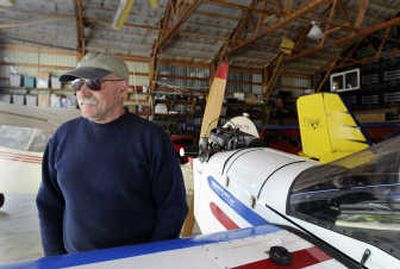Push for ethanol is grounding aircraft

Scientists are calling for a moratorium on biofuels to stabilize the rising price of food, and motorists are noticing a distinct drop in their vehicles’ gas mileage.
But North Idaho pilot Roger Dunham has more reason than most to dislike ethanol: It’s put him out of business.
“My wife calls me the bread loser,” said Dunham, a flight instructor for more then 30 years, because of all the money he’s sunk into his vintage aircraft over time. “But it’s extreme bread-losing now, because we can’t fly.”
Dunham owns several planes, including a 1937 Waco cabin biplane and a 1947 Piper Vagabond Cub, which he uses for promotions and to teach people to fly out of Hackney Airfield in Athol. That is, until recently.
Now he can’t find fuel – at least fuel that he can use.
Most modern small plane engines use a high-octane aviation fuel called 100 low-lead, which burns too hot and contains too much lead for low-compression engines like Dunham’s.
So for the past 25 years, he and more than 60,000 other vintage plane owners have been able to use automobile fuel under a Federal Aviation Administration permit known as a “supplemental type certificate.” These certificates approve modifications to aircraft, including what fuel they use.
But while the FAA allows the owners of antique planes to burn automobile gasoline, it does not approve their use of gasoline with ethanol, and for good reason.
When blended with gasoline, ethanol makes the fuel less volatile, which can lead to vapor lock. Ethanol also collects water and other fuel contaminants, which form acids that eat rubber and composite components in fuel lines, pumps and filters.
The Experimental Aircraft Association, a nonprofit recreational aviation advocacy group, has warned its 170,000 members of this danger, as it lobbies state legislatures to exempt premium gasoline from efforts to oxygenate the nation’s fuel supply.
Yet more and more of the nation’s gasoline distributors are blending gas with ethanol. About six weeks ago, Dunham and other pilots noticed it’s becoming increasingly difficult to find gasoline without it.
“They are just taking these guys right out of the game,” said Ken Jackson, of Sandpoint, a pilot and editor for the Idaho Aviation Association newsletter.
Jackson said some distributors have been willing to supply small quantities of fuel without ethanol, but the volumes are so low there’s not much of an incentive to keep doing it.
“In fact, they have a disincentive because of the tax credit,” he said.
Pushed by corn-state members of Congress, the Energy Policy Act of 2005 provides a tax credit to blenders of gasoline of 5.1 cents per gallon of fuel containing 10 percent ethanol, or E-10, as it is called.
This may explain why as much as 80 percent of the fuel distributed from Spokane terminals is now blended with ethanol, according to local and state distributors. And whatever Spokane gets, North Idaho gets.
In 2006, Idaho lawmakers, encouraged by the state Farm Bureau, attempted to mandate a minimum of 10 percent ethanol in gasoline sold in the state. The legislation failed to make it out of committee.
That year, the Washington Legislature approved a measure requiring 2 percent of all gasoline sold in the state be blended by Nov. 30 of this year.
Washington is well on its way to meeting the goal, according to Kirk Robinson of the state Agriculture Department. But neither the state nor federal law requires all gasoline to be blended with ethanol.
“As far as retailers are concerned, ethanol is cheaper so it’s advantageous to blend it,” Robinson said.
Spokane motorists were required to burn only oxygenated fuel during the winter months for 14 years until the city met federal carbon emissions standards in 2005.
But some environmental organizations are now questioning the benefits of ethanol, which requires energy to produce as well as the use of pesticides and fertilizers needed to cultivate more and more corn.
On Tuesday, a group of international scientists, concerned about increasing corn prices amid a world food crisis, urged a halt to the practice of using food-based biofuels like ethanol.
However, their message came on the same day President Bush called on the nation to increase its use of ethanol as a means of decreasing dependence on foreign oil.
Meanwhile, soaring ethanol production and the drive for profit amid increasing fuel prices has left Dunham grounded, his life’s investment tied up in planes he can no longer fly.